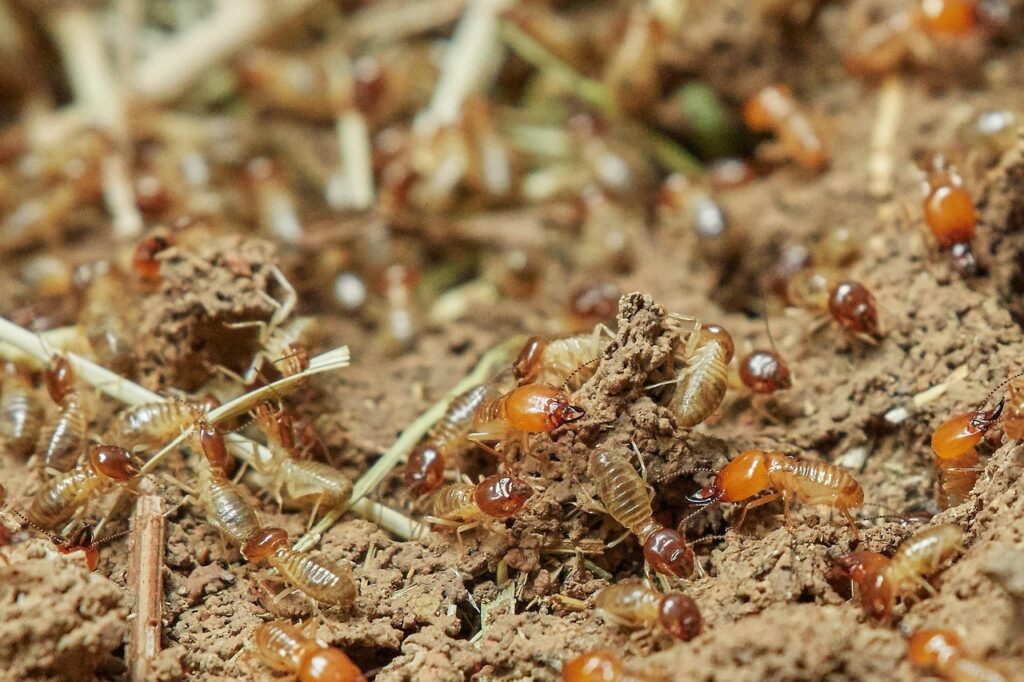Termites are infamous for their ability to destroy wooden structures. Your garden sheds, homes, and fences can all fall victim to their appetite for cellulose.
Owners of metal garages often breathe a sigh of relief, assuming steel structures are termite-proof. Understanding the reality, though, requires deeper insight into how termites behave, what materials they target, and how a metal garage’s design and surroundings can influence termite activity.
The question goes beyond metal panels. It explores whether ancillary elements like wood trim, stored items, soil conditions, and attic insulation can become pathways for termite damage, ultimately undermining the garage’s stability, function, and value.
How Termites Operate
Termites are small social insects that feed on cellulose. This common wood component makes furniture, walls, fences, and packaging materials all vulnerable. Subterranean species form colonies underground and build mud tubes to travel safely to aboveground food. Drywood termites live inside wooden structures that contain enough moisture. Regardless of species, termite infestations depend on food availability, moisture, and shelter.
A metal garage does not provide cellulose for termites to consume. Steel panels, aluminum roofing, and concrete floors offer little interest. What stands out is the garage’s connection to the earth and the potential presence of wooden details. Garage doors, window frames, trim, overhead loft systems, or interior storage can become termite prey. Support beams or false walls inside may provide termites with inviting food sources.
Termites often enter structures through soil buildup against walls, unsealed gaps, or wood-to-ground contact. Even metal garages can host conditions that allow termites to build tunnels around foundational materials. Over time, modest infestations in trim or storage can erode integrity and lead to costly repairs. Thus, understanding termite behavior remains crucial for protecting a metal garage.
Design and Material Influence on Infestation
Proper design helps minimize termite risk in metal garages. Using metal sleepers or piers prevents wood from contacting soil. Concrete pads with appropriate overhangs limit termite shelter near walls. Metal siding and roofing alone resist attack, but attachment fasteners, nuts, washers, and trim often use mild steel or wood components. These parts must be treated or coated to resist termite access.
Insulated panel systems may incorporate wood or foam cores. Termites avoid steel but tunnel through foam or nibble on paper facings. Moisture trapped against insulation fosters mold and invites insect activity. Sealed panel designs and rot-resistant materials reduce these vulnerabilities.
Garages elevated above grade on piers with a gap also reduce damp buildup and termite attractants. Foundation types and building height both affect infestation risk. Inspection of panel edges and under structures is easier when the garage is raised off the soil. Proper architectural planning is key.
Termites and Stored Materials
One of the most frequent causes of metal garage infestations is not the building itself. Stored items become food for termites. Cardboard boxes, wooden furniture, spare lumber, and cardboard packaging provide cellulose. Even paper bags or stacked wood pallets can support a colony. Cardboard is often overlooked as a termite attractant inside otherwise termite-resistant structures.
Moisture worsens the risk. If the garage floods or condensation forms, stored items dampen and termite colonies may form. Inadequate ventilation and lack of airflow lead to humid conditions ideal for termite growth. Inspecting inside the space and removing untreated wood or paper packaging reduces infestation risk.
Shelving systems that rely on wooden supports or chipboard shelves should also be monitored. Termites may tunnel through these structures despite the surrounding metal walls. Storing items off the floor and away from walls helps prevent termite access to vulnerable materials. Metal shelving provides safer long-term storage solutions.
Climate and Local Soil Conditions
Termite pressure differs widely by region. Tropical and subtropical areas have higher termite presence, especially near forests or farmland. Warm, wet climates support subterranean termite colonies which tunnel toward moisture and food. Drywood termites thrive in isolated warm zones and utilize cellulose in attic spaces.
Metal garages can be exposed to high termite risk if they are located in endemic zones and lack preventative measures. Soil contact, stability of moisture, and species-specific behaviors all influence infestation potential. Landscape features may exacerbate the risk. Mulch beds or dense shrubbery near walls can trap moisture and direct termite travel.
Therefore, climate and soil mapping matter. Homeowners in high-risk areas should invest early in termite pre-treatment for soil barriers and moisture control. Strategies may vary for drywood versus subterranean species. Preventive soil treatment helps avoid infestation from entering the enclosure.
Signs of Termite Activity Near Metal Structures
Early detection protects the structure and stored items. Mud tubes along the soil or walls are telltale signs of subterranean termite travel. These pencil-wide tunnels may climb metal doors or conduit lines. Small, wood-like droppings are signs of drywood activity inside wooden crates, pallets, or trim.
Peeling paint or sagging wood sections may hide termite damage. Occasionally, termites feed on paper facings of insulation or along structural plywood mistakenly treated as wood framing. A hollowed-out sound when tapping wooden components is another hint.
Keeping an eye on discarded wings after termite swarms during spring or summer indicates mature colonies nearby. Although the life of these colonies might be underground, presence is cause for inspection and swift action.
Prevention Strategies
Preventing termite infestation in a metal garage starts with design and site management. Position doors and trim above ground, with metal or concrete skirts to block termite access. Use pressure-treated or rot-resistant wood for unavoidable wooden components. Apply sealant to all joints and penetrations in the walls.
Landscaping should maintain clear space around the garage. Keep vegetation and mulch away from walls. Install gravel or crushed rock barriers that draw termites away from foundation walls. Roof overhangs and gutters direct water away from the base.
Regular inspections are necessary. Checking interior walls, trim edges, stored materials, and insulation twice per year uncovers new issues early. Professional termite inspections may include soil probes and monitoring stations around the perimeter.
Treating soils with termiticides and installing bait stations provides ongoing protection, especially in high-risk areas. Homeowners in low-risk climates may opt for periodic drone inspections instead of annual treatments.
Potential Damage and Repair Implications
Termites do not feed on metal, but damage to wooden trims, shelves, and stored items can have cascading effects. Rotting wooden door frames can shift alignment, allowing moisture or pests inside. Failed trim can crack paint, accelerating oxidation of metal panels.
Repairing termite damage requires replacing compromised components, retreating surrounding soil, and improving drainage and ventilation. Neglected infestations may require extensive remediation, as termite colonies expand between garages and nearby homes or wood structures.
Early termite management saves thousands in repair costs. Regular maintenance of wood components including sealing and paints prolongs their life. In severe infestations, fumigation or structural treatment becomes necessary.
Professional Treatment and Remediation
Sometimes prevention is not enough. Pest control professionals offer soil pretreatment, barrier systems, bait stations, and targeted chemical treatment of infested wood. Some services deliver warranties for five to twenty years and periodic inspections.
Chemical foams or direct application in active galleries inside trim can kill inside infestations without removing foundational wood. If fumigation is needed, belongings must be removed temporarily, but a thorough treatment can stop colonies in a single session.
Depending on local regulations, homeowners may need licensed applicators for banned chemicals or termite fumigation. Ultimately, addressing infestation professionally saves future costs and removes uncertainty.
Balancing Metal and Wood in Garage Design
While metal offers excellent termite resistance, hybrid designs with wood elements remain common. Owners must weigh cost and aesthetics with risk. Minimizing wood or protecting it through paint, stain, sealant, and distance from soil helps.
Stainless steel fasteners resist rust where trim meets metal. Interior wood shelving can be replaced with metal or plastic versions. Doors or loft construction using aluminum or pressure-treated lumber reduce termite entry points.
Modern insulated metal panels may contain foam or adhesives vulnerable to termite tunneling. Using termite-resistant insulation and sealed panels ensures performance and longevity.
Environmental Permits and Local Protection Programs
Some areas require environmental certification before termite barriers can be installed. Permits may be necessary to apply termiticides or install monitoring stations. Local agencies or homeowners associations sometimes control termite protection plans to preserve groundwater quality.
Professional exterminators help navigate codes and apply correct products safely. Ongoing warranties and inspection notifications serve as regulatory compliance for treated properties in community plans.
Case Examples
Garage A was built on wood piers with wood-trim edges in a humid region. Seven years post-build, termite damage caused trim collapse and wall panel separation. Repairs included replacing trim with aluminum and sealing foundation gaps.
Garage B, with metal flashings, concrete skirt, soil barrier, metal trim, and professional pre-treatment, remained damage-free after 20 years despite neighboring homes being treated for termites.
Garage C used insulated panels with foam xi and vertical wood posts. Infestation tunneling into foam faced no termite barriers. Remediation required foam removal and soil bait placement at a high cost.
These scenarios reveal how design choices and maintenance strategies directly affect termite vulnerability.
DIY vs. Professional Monitoring
Homeowners comfortable with inspections can manage termite checks themselves if they understand signs. Professional annual inspection gives more comprehensive coverage.
Termite bait station maintenance involves rotating bait and monitoring soil activity. Engaging a licensed inspector ensures better preventative strategies and compliance with warranties or loans.
Next Steps for Metal Garage Owners
Start by reviewing design and landscaping around your garage. Remove wood trim touching soil and replace with metal options. Ensure all stored materials are elevated and inspect insulation facings. Schedule termite inspections and soil treatments if located in high-risk zones.
Maintain good ventilation and drainage. Record inspection dates, materials used, and treatment history. Build relationships with reputable pest professionals familiar with metal structures and steel panel considerations.
Early attention avoids surprise failures. The combination of thoughtful design, routine checks, and historic inspections secures your garage against termite risks.
Conclusion
Termites cannot directly consume metal, but they exploit the weak points of hybrid garages. Efficient design eliminates wood near soil, stored cellulose materials, and damp conditions that encourage infestation. Preventive inspection, soil barriers, and professional treatments are key in termite-prone environments. Professional remediation halts existing infestations before structural damage cascades. Homeowners in low-risk climates may rely on design clarity and occasional inspections.

